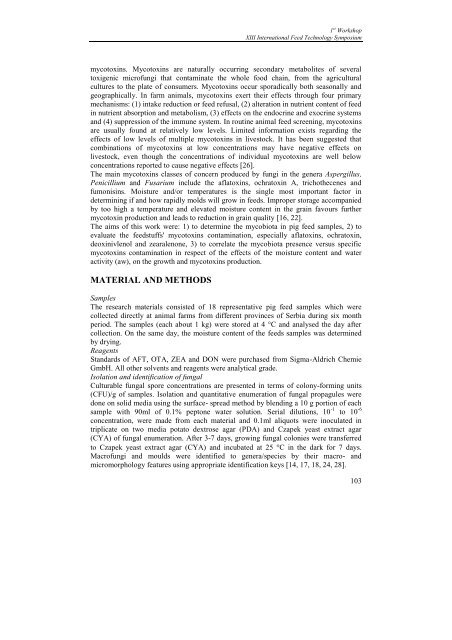Effects of dietary n-3 polyunsaturated fatty acids and ... - FINS
Effects of dietary n-3 polyunsaturated fatty acids and ... - FINS
Effects of dietary n-3 polyunsaturated fatty acids and ... - FINS
Create successful ePaper yourself
Turn your PDF publications into a flip-book with our unique Google optimized e-Paper software.
1 st WorkshopXIII International Feed Technology Symposiummycotoxins. Mycotoxins are naturally occurring secondary metabolites <strong>of</strong> severaltoxigenic micr<strong>of</strong>ungi that contaminate the whole food chain, from the agriculturalcultures to the plate <strong>of</strong> consumers. Mycotoxins occur sporadically both seasonally <strong>and</strong>geographically. In farm animals, mycotoxins exert their effects through four primarymechanisms: (1) intake reduction or feed refusal, (2) alteration in nutrient content <strong>of</strong> feedin nutrient absorption <strong>and</strong> metabolism, (3) effects on the endocrine <strong>and</strong> exocrine systems<strong>and</strong> (4) suppression <strong>of</strong> the immune system. In routine animal feed screening, mycotoxinsare usually found at relatively low levels. Limited information exists regarding theeffects <strong>of</strong> low levels <strong>of</strong> multiple mycotoxins in livestock. It has been suggested thatcombinations <strong>of</strong> mycotoxins at low concentrations may have negative effects onlivestock, even though the concentrations <strong>of</strong> individual mycotoxins are well belowconcentrations reported to cause negative effects [26].The main mycotoxins classes <strong>of</strong> concern produced by fungi in the genera Aspergillus,Penicillium <strong>and</strong> Fusarium include the aflatoxins, ochratoxin A, trichothecenes <strong>and</strong>fumonisins. Moisture <strong>and</strong>/or temperatures is the single most important factor indetermining if <strong>and</strong> how rapidly molds will grow in feeds. Improper storage accompaniedby too high a temperature <strong>and</strong> elevated moisture content in the grain favours furthermycotoxin production <strong>and</strong> leads to reduction in grain quality [16, 22].The aims <strong>of</strong> this work were: 1) to determine the mycobiota in pig feed samples, 2) toevaluate the feedstuffs' mycotoxins contamination, especially aflatoxins, ochratoxin,deoxinivlenol <strong>and</strong> zearalenone, 3) to correlate the mycobiota presence versus specificmycotoxins contamination in respect <strong>of</strong> the effects <strong>of</strong> the moisture content <strong>and</strong> wateractivity (aw), on the growth <strong>and</strong> mycotoxins production.MATERIAL AND METHODSSamplesThe research materials consisted <strong>of</strong> 18 representative pig feed samples which werecollected directly at animal farms from different provinces <strong>of</strong> Serbia during six monthperiod. The samples (each about 1 kg) were stored at 4 °C <strong>and</strong> analysed the day aftercollection. On the same day, the moisture content <strong>of</strong> the feeds samples was determinedby drying.ReagentsSt<strong>and</strong>ards <strong>of</strong> AFT, OTA, ZEA <strong>and</strong> DON were purchased from Sigma-Aldrich ChemieGmbH. All other solvents <strong>and</strong> reagents were analytical grade.Isolation <strong>and</strong> identification <strong>of</strong> fungalCulturable fungal spore concentrations are presented in terms <strong>of</strong> colony-forming units(CFU)/g <strong>of</strong> samples. Isolation <strong>and</strong> quantitative enumeration <strong>of</strong> fungal propagules weredone on solid media using the surface- spread method by blending a 10 g portion <strong>of</strong> eachsample with 90ml <strong>of</strong> 0.1% peptone water solution. Serial dilutions, 10 -1 to 10 -6concentration, were made from each material <strong>and</strong> 0.1ml aliquots were inoculated intriplicate on two media potato dextrose agar (PDA) <strong>and</strong> Czapek yeast extract agar(CYA) <strong>of</strong> fungal enumeration. After 3-7 days, growing fungal colonies were transferredto Czapek yeast extract agar (CYA) <strong>and</strong> incubated at 25 C in the dark for 7 days.Macr<strong>of</strong>ungi <strong>and</strong> moulds were identified to genera/species by their macro- <strong>and</strong>micromorphology features using appropriate identification keys [14, 17, 18, 24, 28].103
















